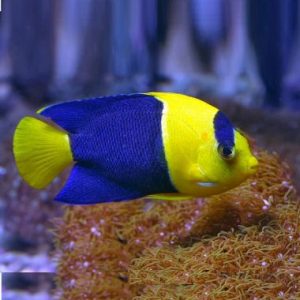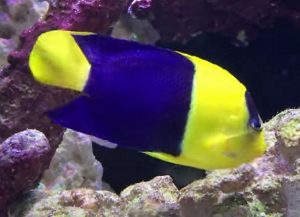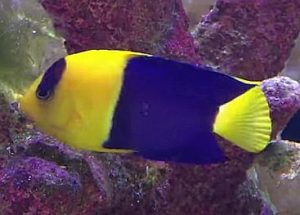The Bicolor Angelfish (Centropyge bicolor) known to tropical fish keeping enthusiasts as the Oriole Angelfish, Blue and Gold Angel, Pacific Rock Beauty, Two Colored Angel, and the Dwarf Oriole Angel is a dwarf Indo Pacific species found in New Caledonia, Fiji, Papua New Guinea, Micronesia, and surrounding area reefs.
Bicolor Angelfish (Centropyge bicolor) are one of the less aggressive dwarf angelfish species that are safe to house with other peaceful fish. In their natural habitat Bicolor Angelfish are most often seen in pairs or small aggregations in brackish lagoon waters and along the reef slopes at depths ranging from 10 to over 80 feet.
Like most angelfish species, they will not tolerate each other in the small confines of a marine aquarium and should never be housed with other dwarf angelfish or similar looking species unless an extremely large tank is provided with plenty of hiding places.
Many tropical fish keeping enthusiasts consider them an excellent addition to mixed species tanks and even some reef aquariums, however, they will nip on large polyped stony corals, smaller corals, sessile invertebrates, and the mantles of clams and are not considered reef safe.
The Bicolor Angelfish (Centropyge bicolor) has a a vibrant yellow anterior body color that ends just behind the pelvic fins where it splits into a deep blue at the mid point, to end at the posterior at the base of the yellow tail. A small purple to royal blue splash runs from one eye over the top of the forehead down through the other eye.
There are no distinguishable differences in size or color between males and females.
Because of their mild temperament, striking coloration, ease of care, and availability to tropical fish keeping enthusiasts, the Bicolor Angelfish is regarded as the most popular Angelfish species in the aquarium trade.
Depending on the amount of tank inhabitants, a single Bicolor Angelfish can be housed in a community tank of at least 70 gallon capacity with an abundance of mature live rock for grazing that is arranged into caves, overhangs, and crevices for them to hide among. Adult Centropyge bicolors spend most of their time grazing on the naturally occurring algae that grows on live rocks which makes an abundance of cured mature live rock mandatory for keeping this species healthy. Also, a well feed angelfish is far less likely to nibble on a coral or crustacean in a reef tank.
Unless you plan to try breeding a pair, only one dwarf Centropyge bicolor should be housed per tank. Examples of other compatible tank mates are Blennies, Damselfish, Cardinals, Hawkfish, Tangs, and Wrasses. Avoid keeping them with larger Basses, Groupers, Lionfish, or Triggers that may harass or eat smaller species.
Although Bicolor Angelfish are not considered to be reef safe and are prone to nipping on soft and stony corals, clam mantles, feather dusters, and anemones; they are less likely to consume SPS corals and will often ignore these corals entirely if mature live rock is present
Like many Angelfish, Bicolor Angelfish are protogynous synchronous hermaphrodites and regarded as difficult to breed in an aquarium environment. All juvenile fish will initially develop into females. When conditions exist that promote prorogation of the species, the largest and most dominant female will transform into a male. The introduction of several juveniles together into an aquarium will eventually result in a single male and a harem of females.
Although Centropyge bicolor have been successfully bred in captivity, reported incidents are extremely rare.
In their natural environment, juvenile Bicolor Angelfish feed on plankton. As they mature and become adults, they graze on marine algae, worms, small crustaceans, and clams. In an aquarium environment that includes large quantities of cured live rock, they should be fed a frozen marine angelfish preparation as a staple; augmented with Mysis shrimp, brine shrimp, fresh chopped mollusks, crustaceans, dried spirulina or frozen algae, and “treats” of zucchini, spinach, or yellow squash. Feeding small quantities 2 or 3 times daily is recommended.
Bicolor Angelfish (Centropyge bicolor) have a reputation as being difficult to keep and not being very hardy. This can be attributed to the location where the fish are collected from, especially the Philippines, and how they have been acclimated. Some fish collectors employ questionable collecting practices. Always request hand netted specimens rather than those collected using chemicals and make sure that your supplier provides a survival guarantee before you purchase one. Bicolor Angelfish should only be added to well established tanks that have been setup up for at least 6 months.
Bicolor Angelfish (Centropyge bicolor) are readily available to tropical fish keeping enthusiasts from a variety of sources online and from local tropical fish shops at reasonable prices at the following approximate purchase sizes: Small: 1″ to 1-3/4″; Medium: 1-3/4″ to 2-1/2″; Large: 2-1/2″ to 4-1/2″.
Minimum Tank Size: 70 gallons
Aquarium Type: Reef Compatible with caution
Care Level: Moderate
Temperament: Semi-aggressive
Aquarium Hardiness: Hardy when acclimated
Water Conditions: 72-78°F, dKH 8 to 12 , pH 8.1 – 8.4, sg 1.020-1.025
Max. Size: 6″
Color Form: Blue, Yellow
Diet: Omnivore
Compatibility: Single species
Origin: Fiji, Indonesia, Melanesia
Family: Pomacanthidae
Lifespan: 12 years
Aquarist Experience Level: Intermediate





2 Responses to “Bicolor Angelfish (Centropyge bicolor)”
Trackbacks/Pingbacks
[…] been known to pick at other blennies, gobies, dartfish and even other species like Royal Gramma and Bi color Angelfish that have similar color markings. Some fish that get along well with the Bicolor Blenny […]
[…] Damselfish Dartfish (Fire Dartfish) Dottybacks Dragonets (Mandarin Goby) Dwarf Angelfish like (Bicolor Angel) […]